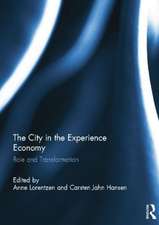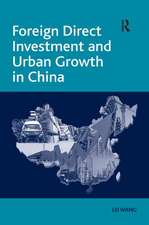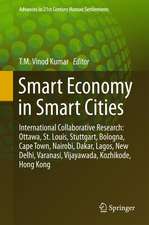Creative Economies in Peripheral Regions
Autor Patrick Collins, James A. Cunninghamen Limba Engleză Hardback – 20 iul 2017
This is the first study to draw on international research carried out across four EU member states to add to the neglected area of the creative economy of peripheral regions.
Economies are dynamic entities and subject to constant flux. Driven by changing tastes, new ways to make and disruptive innovations, new routes of economic development present themselves at ever increasing rates. This study is concerned with the rise of the creative economy. UNCTAD has marked the emergence of the creative economy across the globe and noted its resilience in the face of recent economic turmoil. Here, the authors intend to bring the level of analysis down to the regional and firm level by uncovering the extent of the creative economy in some of Europe’s most peripheral regions.
| Toate formatele și edițiile | Preț | Express |
|---|---|---|
| Paperback (1) | 680.49 lei 38-44 zile | |
| Springer International Publishing – aug 2018 | 680.49 lei 38-44 zile | |
| Hardback (1) | 727.97 lei 6-8 săpt. | |
| Springer International Publishing – 20 iul 2017 | 727.97 lei 6-8 săpt. |
Preț: 727.97 lei
Preț vechi: 887.76 lei
-18% Nou
Puncte Express: 1092
Preț estimativ în valută:
139.29€ • 145.45$ • 115.03£
139.29€ • 145.45$ • 115.03£
Carte tipărită la comandă
Livrare economică 15-29 aprilie
Preluare comenzi: 021 569.72.76
Specificații
ISBN-13: 9783319521640
ISBN-10: 3319521640
Pagini: 225
Ilustrații: XIX, 229 p. 16 illus.
Dimensiuni: 148 x 210 x 20 mm
Greutate: 0.45 kg
Ediția:1st ed. 2017
Editura: Springer International Publishing
Colecția Palgrave Macmillan
Locul publicării:Cham, Switzerland
ISBN-10: 3319521640
Pagini: 225
Ilustrații: XIX, 229 p. 16 illus.
Dimensiuni: 148 x 210 x 20 mm
Greutate: 0.45 kg
Ediția:1st ed. 2017
Editura: Springer International Publishing
Colecția Palgrave Macmillan
Locul publicării:Cham, Switzerland
Cuprins
1. Creative Economies: Drivers, Challenges, Urban and Rural Divide .- 2. Cultural Consumption: Implications for Peripheral Regions.- 3. The Uniqueness of Peripheral Creative Economies.- 4. Policy Considerations, Creative Firms Business Models and Future Research.
Notă biografică
Patrick Collins is an economic geographer who has published in the areas of regional development, the information society, and the impact of telecommunications provision. Recently, Patrick has investigated the economic contribution of creative and cultural industries to Galway and the west of Ireland more generally. Patrick is currently Lecturer at the School of Geography and Archaeology NUI Galway.
James A. Cunningham is Professor of Strategic Management at Newcastle Business School at Northumbria University. His research interests intersect innovation, entrepreneurship and strategic management. His current research interests include strategy issues with respect to principal investigators as scientific entrepreneurs and market shapers; university technology transfer and commercialisation; academic and technology entrepreneurship and entrepreneurial universities.
James A. Cunningham is Professor of Strategic Management at Newcastle Business School at Northumbria University. His research interests intersect innovation, entrepreneurship and strategic management. His current research interests include strategy issues with respect to principal investigators as scientific entrepreneurs and market shapers; university technology transfer and commercialisation; academic and technology entrepreneurship and entrepreneurial universities.
Textul de pe ultima copertă
This book discusses the rise of the creative economy. Organisations like UNCTAD have observed the emergence of the creative economy across the globe and noted its resilience in the face of recent economic turmoil. Here, the authors intend to bring the level of analysis down to the regional and firm level by uncovering the extent of the creative economy in some of Europe’s most peripheral regions.
This is the first study to draw on international research carried out across four EU member states to add to the neglected area of the creative economy of peripheral regions. Chapters discuss the drivers and challenges of creative economies, the implications of cultural consumption on peripheral regions, the uniqueness of peripheral creative economies and policy considerations arising from the creative economy. The work contributes to expanding theory in the areas of economic geography, business studies and regional development.
This is the first study to draw on international research carried out across four EU member states to add to the neglected area of the creative economy of peripheral regions. Chapters discuss the drivers and challenges of creative economies, the implications of cultural consumption on peripheral regions, the uniqueness of peripheral creative economies and policy considerations arising from the creative economy. The work contributes to expanding theory in the areas of economic geography, business studies and regional development.
Caracteristici
Exclusively focuses on the creative economy in peripheral regions. The focus to date has been predominately urban Draws on comparative data on the creative economy and peripheral regions in Europe that provide insights into the structure and challenges faced by creative economies in peripheral regions Presents a business model for emerging companies and outlines policy recommendations for developing this industry in peripheral areas














